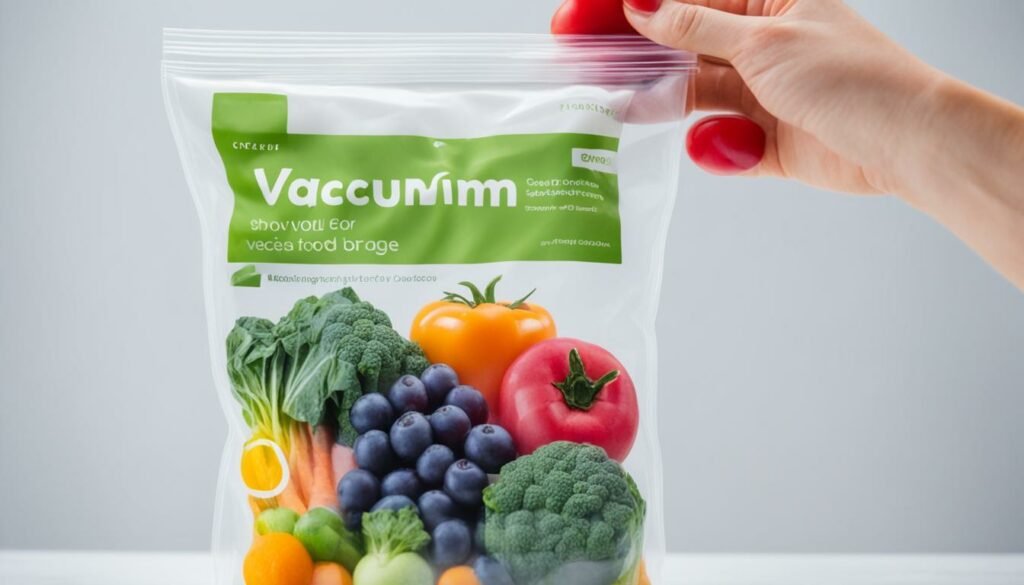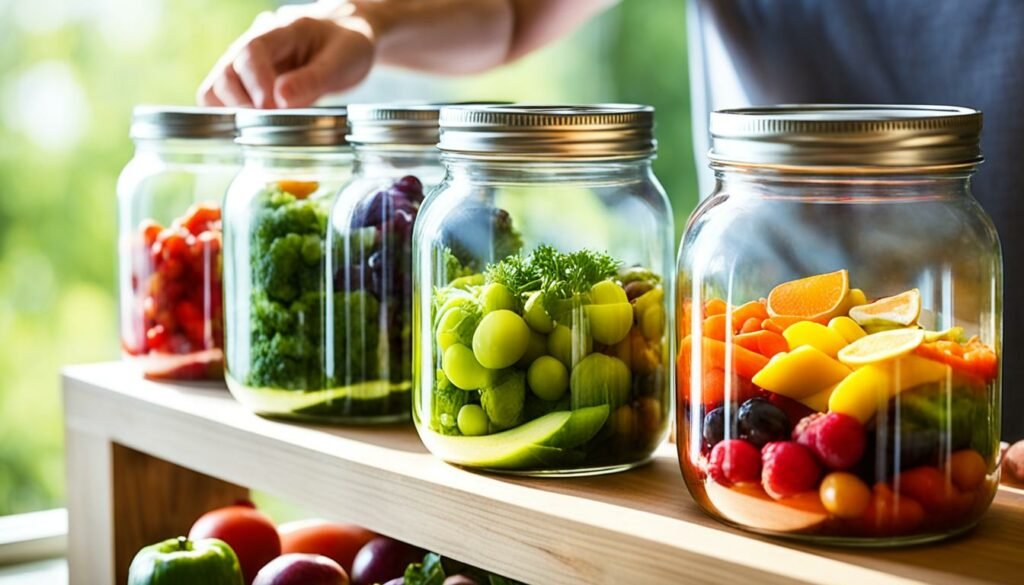I’ve always been intrigued by the art of food preservation. As a dedicated cook and meal prepper, I’ve delved into various methods to maintain food freshness. Two approaches frequently discussed are vacuum sealing and canning. While both have their strengths, the ease of use varies significantly between these time-saving methods.
Vacuum sealing is a contemporary, user-friendly technique that eliminates air to preserve food. In contrast, canning is a traditional method that sterilizes food with heat in jars. Both aim to prolong shelf life, yet their approaches are distinct. Let’s examine these preservation techniques and evaluate their ease of use.
Understanding Food Preservation Methods
Food preservation has been essential for human survival throughout history. I find it intriguing how we’ve transitioned from basic salt-curing to advanced methods that simplify kitchen tasks. This journey through food preservation reveals its evolution and impact on our lives.
The Importance of Food Preservation
Preserving food is vital for several reasons. It minimizes waste, conserves funds, and allows us to enjoy our favorite dishes all year. Historically, it was crucial for survival during winter or scarcity. Now, it’s about finding efficient storage solutions for our fast-paced lives.
Evolution of Preservation Techniques
Our forebears employed straightforward methods like drying, smoking, and fermentation. These methods remain effective, but we’ve incorporated new strategies. Freezing became widespread with refrigerators, offering a swift and effortless preservation method at home.
Modern Approaches to Extending Shelf Life
Today, beginner-friendly approaches make food preservation accessible to all. Vacuum sealing revolutionized food storage, keeping food fresh with minimal effort. Canning has also advanced, featuring safer and more efficient techniques that anyone can learn.
These contemporary methods not only prolong food shelf life but also preserve its nutritional value and taste. As we continually seek practical storage solutions, the preservation art will undoubtedly evolve to suit our needs.
Vacuum Sealing: A Modern Approach to Food Storage
Vacuum sealing has transformed the realm of food preservation. It’s a method that seamlessly integrates with sustainable living. This technique is at the forefront of modern culinary trends, making meal prep effortless.

How Vacuum Sealing Works
The process is straightforward yet potent. It involves removing air from bags or containers, creating a vacuum seal. This absence of oxygen hinders bacteria and mold growth, extending the shelf life of food.
Types of Foods Suitable for Vacuum Sealing
Vacuum sealing is adaptable and suitable for a wide range of foods:
- Meats and fish
- Fresh fruits and vegetables
- Dried goods like nuts and cereals
- Baked goods and snacks
Benefits of Vacuum Sealing
The benefits of vacuum sealing are extensive:
- Extended shelf life: Food remains fresh up to five times longer
- Space-saving: Sealed packages occupy less space in your fridge or pantry
- Cost-effective: Reduces food waste and allows bulk purchases
- Preserves quality: Retains flavor, texture, and nutritional value
- Convenient: Ideal for hassle-free meal prep and portion control
While vacuum sealing has numerous advantages, canning also stands out. Canning can preserve food for up to 30 years without refrigeration. Both methods are essential for a comprehensive food preservation strategy.
Canning: A Time-Tested Preservation Method
Canning is a reliable method for preserving food. It’s a practical way to store food, involving the sterilization of food in airtight jars. This process kills off harmful microorganisms, thereby extending the shelf life of the food.

Canning is versatile, suitable for a broad spectrum of foods including fruits, vegetables, and liquids. The shelf life of canned foods can range from 1 to 5 years, with some items lasting up to 30 years. This makes it a prime choice for long-term storage.
Although canning might not be as time-efficient as vacuum sealing, it has distinct advantages. It’s particularly effective for preserving jellies, marmalades, pickles, and oils. While it requires more effort, the outcome is well worth it.
Here’s a quick comparison of canning and vacuum sealing:
| Aspect | Canning | Vacuum Sealing |
|---|---|---|
| Shelf Life | 1-30 years | 6 months – 3 years |
| Time Required | More | Less |
| Best For | Fruits, vegetables, liquids | Dry goods, meats |
| Food Alteration | May change texture/taste | Minimal changes |
Initially, canning might seem daunting, but with practice, it becomes simpler. It’s crucial to acknowledge that canning can slightly alter the food’s original shape, taste, and nutrient content. Yet, for those seeking long-term storage solutions, canning remains a highly effective method.
Ease of Use: Vacuum Sealing vs. Canning
I’ve delved into both vacuum sealing and canning, uncovering their ease of use. These preservation techniques cater to different kitchen needs and lifestyles. They offer varying levels of convenience.
Time and Effort Required
Vacuum sealing is a swift method, perfect for busy schedules. It’s easy to use, making it ideal for daily preservation. In contrast, canning requires more time and patience. While it’s rewarding, it’s not as quick as vacuum sealing for those prioritizing kitchen convenience.
Equipment and Materials Needed
Vacuum sealing is simpler in terms of equipment. You just need a sealer and bags, which are easily accessible. Canning, however, demands specialized tools like jars, lids, and a pressure or water bath canner. This makes vacuum sealing more accessible for beginners in food preservation.
Learning Curve and Skill Level
Vacuum sealing has a more straightforward learning curve. It’s intuitive and doesn’t require deep knowledge. Canning, while manageable, involves more steps and safety measures. For those new to food preservation, vacuum sealing is a more accessible option. Yet, canning can be mastered with practice, offering distinct advantages for long-term storage.
FAQ
What is the main difference between vacuum sealing and canning?
Vacuum sealing removes air to preserve food’s original taste and shape. Canning, on the other hand, sterilizes food in heat and seals it in airtight jars for longer storage.
Which method is quicker and easier?
Vacuum sealing is quicker and easier than canning, ideal for busy households. It requires less equipment and is simpler to learn.
What types of foods are suitable for vacuum sealing?
Vacuum sealing works well with a broad range of foods. This includes proteins, fruits, vegetables, and even baked goods.
How long can canned foods last?
Canned foods can last from 1 to 5 years, and sometimes up to 30 years. This depends on the type of food and the canning process used.
What are the benefits of vacuum sealing?
Vacuum sealing offers several advantages. These include longer shelf life, cost savings, efficient use of space, and preserving food quality without the need for chemicals or preservatives.
Which method requires more time and effort?
Canning takes more time and requires specific gear like pressure or water bath canners. In contrast, vacuum sealing is generally faster and simpler.
Which method is better for long-term storage of certain foods?
For long-term storage, canning is the better choice. It’s ideal for items like jellies, marmalades, pickles, and oils. This is because the heat sterilization process provides a longer shelf life.
